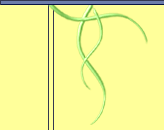Painting the Hilt and Pommel
First, you need to get set up in a well ventilated area - preferably outside.
The amount of acetone that will be off-gassing from the paint is much more
than even a kitchen hood venting to the outside can handle.
Wet the rag with the vinegar and rub the handle and pommel on every surface.
It is VERY important that you rub the handle vigorously in order to remove all of the
dust and grease; this will ensure that the paint sticks to the handle.
Do NOT use paper towels or any material that leaves any sort of residue.
Let the handle/pommel dry for 15 minutes
Lay out your work area so that everything is within easy reach.
Next, mix the paint thoroughly because over time the color pigments tend to
separate from the liquid binder. You may use a toothpick or a popsicle stick,
or any other small, clean stirring device.
Scoop out a small amount of the paint with your stick and scrape it off into your fresh paint pot,
then securely close the main pot.
Pour about ½ an ounce of acetone into a clean disposable container. Dip your brush
into the acetone and carry a brushful at a time to the paint pot to begin thinning
the paint. Add only a bit at a time - you can test how it flows on the freezer paper.
Acetone evaporates VERY quickly and the paint’s secondary liquid binder evaporates almost
as fast. You can only thin the paint with acetone five or six times before the binder sets
up. You’ll know it when you see it - instead of flowing, the paint will form many tiny
balls of color in the puddle of acetone. When that happens, you have to wipe out the pot
with some paper towels and pour some more fresh paint, or use a fresh pot.
Once you have it flowing to your liking, apply the paint in thin layers. Use a ‘brushing’
technique rather than "dabbing" when applying the paint, especially with metallic colors.
Note that if the layers are applied too thickly it won’t dry correctly and it might not stick well.
Let it dry for 24 hours at room temperature and be careful to keep
everything off of the wet paint.
You now have a weapon personalized to your specifications!!!
Clean up your paintbrush with the acetone and wash immediately with liquid soap
and water. Let the brush dry completely before using it again.
Apply as many colors as you want using this procedure, but I would recommend dedicating
a brush to each color by marking the handle with the paint color.
Painting The Blade
If you wish to paint the blade, for example to add Celtic Runes, or you
would like to paint the Elven Runes etched into the
Elven Blade, then be sure to use THIN layers of paint!
Also be sure to allow each layer of paint to fully dry before applying the next thin layer,
Be warned: thick layers of paint on any flexing surface, like the foam blade of a
LARP weapon, will cause the paint to crack very quickly. THIN layers allow for some
flexibility in the paint.
Try not to paint the striking surface (the business edge) of any LARP weapon. That
is where most of the friction and flexing will occur, and that is the area where
paint will last the least amount of time.
One way to paint the blade without falling into the traps mentioned above is to use
thin layers of paint and put a gradient hue on the blade, with the most paint on the
back of the blade and thinning to no paint at all a good .5 to .75 inches before
you reach the edge of the blade, and a full inch before reaching the tip of the blade.
If you want the entire blade to be a color other than the standard "steel", the factory
needs to change the color they use when creating the blade. The fee for creating a customized
blade color at this time is $30 US dollars per blade, and it will take four to six weeks
for the weapon to be completed and delivered.
To order any Calimacil blade with a custom blade color, purchase the weapon(s) as usual, then
1) purchase $30 dollars worth of
Gift Certificates for each customized blade, and
2) Specify each blade to be customized and its custom blade color, then
3) CALL ME at 972-979-8753 after you have placed the order to confirm your
color choices and to erase all possiblility of any misunderstanding!
Fortify The Hilt and Pommel
If you wish to reinforce the hilt and/or the pommel after the paint has dried, you can
either spray it with several thin coats of Testor’s brand sealant;
choose the finish you prefer (matte or gloss) - OR - you can
fortify the hilt and pommel using clear DIP.
Some No-No's
- Paint solvents attack plumbing so use the trash when disposing of waste material
- Do not inhale fumes from either the solvent nor the paint
- Do not apply thick layers of paint on the blade as it will crack
- Do not apply paint on the striking surfaces of any blade as it will wear and crack very quickly
- Do not clean the blade with vinegar
Top of Page
























